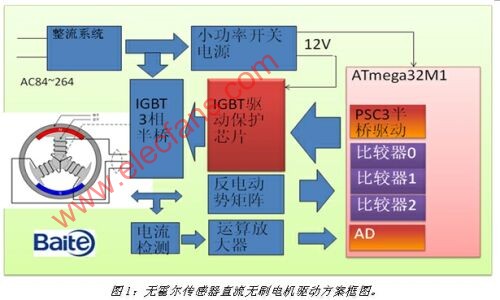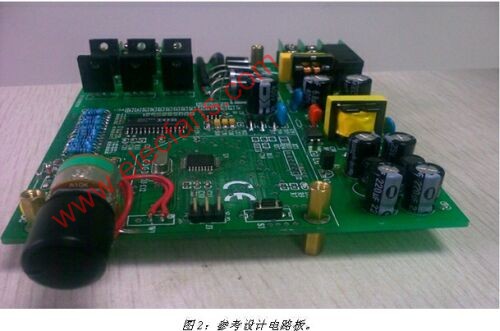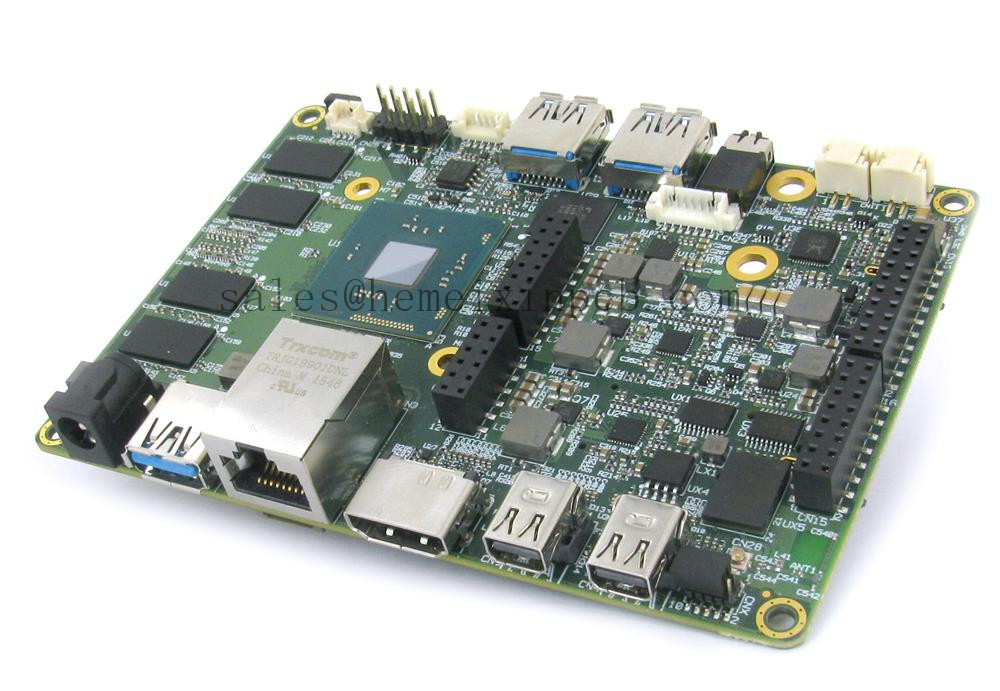Atmega32M1 power tool motor drive solution
Brushed DC motor brushes have high wear and tear, often fail, and are more troublesome to maintain. With the advancement of technology, brushless DC motors have gradually replaced the brush motors that were widely used in the past. The three Hall sensors sense the position of the rotor to complete the commutation, which greatly improves the service life of the motor and also replaces the mechanical change. More reliable to DC motors, more suitable for control systems. However, each Hall sensor has a lead. The increase in the number of leads also means a certain increase in cost compared to the previous brushed motor, which also increases the risk of failure. The brushless and non-Hall DC motor eliminates the lead of the Hall sensor on the basis of this, and ensures the reliability on the basis of cost reduction, so it is more and more widely used.
Baxter Electronics has developed a set of “No Hall Sensor DC Brushless Motor†solution for power tools. Direct access to 220V mains can drive electric tools such as electric drills to work normally, and it is also convenient to adjust speed. Going to the Hall sensor leads reduces the potential for potential failure.
The solution uses Atmel's 8-bit MCU Atmega32M1 as the master chip. The chip integrates PWM modulation, 32KB of programmable Flash memory, 2KB SRAM and 1KB EEPROM, and an 8-channel 10-bit A/D converter. Figure 1 and Figure 2 show the block diagram and reference design board, respectively.

The circuit can be divided into three parts: input and switching power supplies, MCU control and IGBT drivers. The system detects the rotor position by the back electromotive force method, sends a control signal according to the rotor position, changes the current value of the PWM, and then changes the conduction sequence of the IGBT to realize the control of the motor speed. Back EMF detection is key. The Atmega32M1 has three separate comparators for back EMF measurement of the motor. Its 12-bit multi-purpose synchronous power stage controller has a clock frequency of up to 64MHz and provides six complementary programmable high-speed accuracies. Signal to control the three half bridges of the motor. In addition, Baxter's back-EMF algorithm can ensure the accuracy of rotor position detection, and it is safe and reliable for power tools that directly use 220V mains.
In brushless DC motor systems, circuit protection plays a very important role. The Atmega32M1 has an additional comparator for overcurrent detection with a reference level (comparative level) that can be either a DAC output or any external reference voltage. The temperature detection, operation amplification and conditioning circuit and A/D converter ensure that the system does not cause overvoltage, overcurrent, etc., which may affect the normal operation of the circuit and even cause damage when the external input is abnormal. In addition, the hardware fault detection module automatically sets the motor to a safe state as soon as it detects a fault.
Zhang Yifeng, an engineer at Baxter Shanghai Technology Center, introduced that Baxter Electronics began designing this solution in 2009. It has been basically completed and is undergoing final testing with customers. It is expected to be available in volume in the second quarter of this year. .
In addition to the application of the Atmega32M1 solution, the body control of the car is one of the future applications. As the number of motors in automobiles increases, automotive manufacturers need smaller, lighter, and more powerful motor products with brushed motors. Manufacturers are gradually switching to brushless DC motors that require more sophisticated electronics to precisely control speed and torque, presenting new challenges for automotive manufacturing, including high temperature issues, as some hoods have application temperatures of up to 150 °C.
The ATmega32M1 is designed for this need. It uses a high-performance AVR 8-bit RISC architecture that integrates all the basic peripherals that meet the requirements of complex algorithms, including various analog blocks, such as 10-bit ADCs with differential amplifiers and programmable gain options, and selectable levels. Analog comparator, I/O pin change interrupt. The ATmega32M1 has all the resources needed to control a brushless DC motor in an automotive system environment.
The window lift motor control with anti-pinch function is the occasion where the brushless DC motor works. The control of ventilation and air conditioning also belong to the same type of application. Another key requirement for using embedded processors in automotive electronics is that CAN and LIN communication protocol stacks must be efficient and well supported. Atmel's control solutions have always been a leader in the automotive industry. The ATmega 32M1 also supports CAN/LIN, making it ideal for automotive electronics applications. According to reports, Baxter Electronics will also develop automotive electronics, home appliances and other applications based on this chip.

We are excel in providing Wireless PCB Manufacturing and Wireless PCB Assembly for cell phones Broadband Cards, GPS Devices, Ethernet Cards, Satellite Modem and more devices

You now have a cost effective alternative to flat cable and expensive connector integration approaches: multi-layer Flexible Printed Circuits where each layer is produced using adhesive and adhesiveless type polyimide (PI) film substrates with copper trace thicknesses ranging from 18um to 140um. Your design can be rendered into multilayer stackups that include single and multiple air gaps for conformal installations, conventional plated through hole (PTH) plating, plus coverlay and solder mask circuit protection.
Wireless PCB Assembly
EMS PCB,SMT PCB,Electronic Circuit Board Assembly
Hemeixin Electronics Co.,Ltd. , http://www.rigidflex-pcb.com